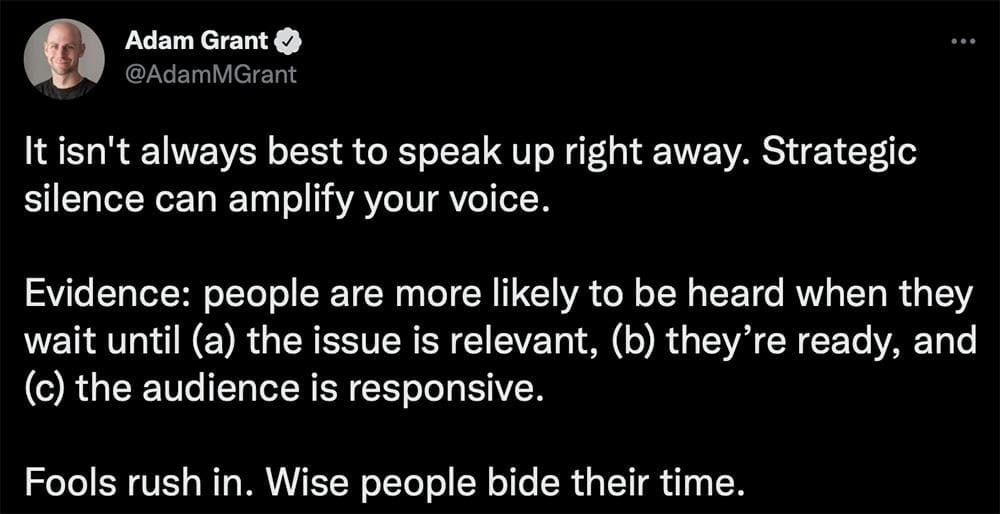Are we conditioning our employees not to speak up? The traits present in our best employees might make them less likely to raise issues, concerns and ideas. Compliance expert Courtney Sander explores integrating speaking-up practice within the business to benefit your compliance program and the broader organization.
What makes good employees great can hurt a speak-up culture. I started down this path a few weeks ago when Adam Grant posted this:
 If you’re not already following Adam Grant, I’d recommended doing so on Twitter, LinkedIn, or Instagram.
If you’re not already following Adam Grant, I’d recommended doing so on Twitter, LinkedIn, or Instagram.
So I dug into the referenced article a bit more. It’s all about strategic silence, a concept that says employees withhold their ideas until the “right time.”
Each of us reports to a people manager, and so we’ve all been conditioned to raise issues, concerns and ideas at the “right time,” meaning they’re all of these:
- Relevant to the discussion or project.
- Thought through and we’re delivering a solution.
- Going to be received well by our manager or project leader.
We avoid speaking up because we know it can be disruptive, take time away from the projects and tasks at hand and bring up interpersonal issues that need to be resolved before the team can move forward. Quite frankly, being that person hasn’t historically looked good.
And when we do this, we’re seen as a valuable employee who’s rewarded with good assignments, leadership roles, praise, promotions or bonuses.
People managers rely on strategic silence to weed out lower quality issues, concerns and ideas, so we withhold them until we feel our voice is strong and timely. What’s worse, research suggests that women feel the burden to stay strategically silent even more so than men in order for their voices to be valued and to be rewarded by managers.
However, keeping concerns and ideas to ourselves is emotionally demanding and increases stress. So, why do we continue to jeopardize our well-being in order to keep up appearances at work?
I don’t want to overlook other reasons employees stay quiet like fear, futility, disengagement and deviance. These are cultural issues that should also be addressed, but these are things that the compliance team cannot solve alone.
Having spent more than a decade in the compliance and ethics space, I know that employees are better at speaking up than we give them credit for. But we must do better at advocating for processes outside of compliance and ethics that encourage them to speak up in ways that make sense for the business. We must ensure our employees feel that they can speak up even if they don’t have all the facts and ensure we provide a positive response.
It’s an added bonus that doing all of this could improve employee well-being.
Give your employees a low-risk, relevance-agnostic way to raise their ideas and practice speaking up
As a people manager, I wanted my team to bring ideas to the table that were relevant and thought through, but I also wanted to be responsive. And running the day-to-day of a growing small business didn’t always lend itself to responsiveness.
I had a great team that was full of great ideas, but oftentimes, I was the reason that now wasn’t the “right time” for the idea to be raised. Instead of just shutting down good ideas (because, disengagement), I asked my team to put their ideas on the backlog: a list of projects or tasks to be reviewed and refined before putting them into production. My response was often, “OK, cool. Put it on the backlog.” And if the idea went to the backlog before it was even presented to me — even better!
The backlog wasn’t a black hole where good ideas go to die. In fact, it was accessible to everyone on the team so each person could add new ideas and contribute to those others had previously shared. We kept a structured backlog so that when the time was right, I could review the backlog on my own time, ask questions and give feedback directly in the app that managed our backlog, consult with the team and then decide on next steps.
When someone from the team put something on the backlog, there were a series of questions and fields that needed to be completed. Not only was this for me to understand the idea but also for the person to think through their idea and get as many details written down so they could discuss it days or weeks down the road when the time was right. For all of the compliance practitioners out there, this is the same concept as writing a good investigation report: The general goal is to draft the report in such a way that an uninvolved third party would understand the concerns, investigation process and outcome.
The big key here is timeliness. Having an established, end-to-end process means that adding something to the backlog takes only a few moments of an employee’s time, it’s manageable when reviewed regularly and doesn’t derail any person or their projects.
Having a structured process like this also promotes equity and fairness across the team and eliminates issues like proximity bias (favoring employees you see or interact with more regularly) or rewarding only the loudest voices. And the backlog becomes part of your institutional knowledge and good ideas don’t fizzle when employees move into new roles or companies.
It’s OK to not have all the answers at this moment
We’re conditioned to only speak up when we have all the right answers, and that fails us when we’re trying to raise bigger concerns where we might not have timely access — or any access at all — to all of the answers.
Repeat after me. It’s OK to not have all the answers.
Often, ideas take a long time to completely mature, or you hit a roadblock and aren’t sure where to go next. That’s why you have a diverse team with unique perspectives. Asking employees to share their ideas doesn’t mean you’re asking employees to win a 100-meter dash. Sharing an idea can be a 4×100 relay where each member of the team relies on each other to carry the baton and hand it off to the next person.
Handing off the baton when sharing ideas means you and your team have to be comfortable in answering questions with “not sure” or “I don’t know.” Both are OK answers! In fact, if your team is using some sort of collaboration tool, you can “at” someone else and have them weigh in as well. Pass the baton and finish the relay together!
Making a report to the compliance helpline is much the same. If employees are comfortable not having the answers in day-to-day business, they’ll be more comfortable in raising concerns when they don’t have all the facts or evidence. The compliance team must be thought of as part of the relay team.
This doesn’t mean that the compliance team is picking up the entire company’s responsibilities. If your job duties require you to run the 100-meter dash, you need to run the 100-meter dash. You can let compliance know that you’re running the race and they’ll be there to make sure you’re on the right course and cheer you along.
Give positive feedback to your team
Just as all reports to the compliance helpline deserve an acknowledgement, so do all ideas on the backlog. When employees receive a genuine response, we’re giving them positive feedback and motivating them to repeat this behavior.
And since most of us didn’t go to manager school, knowing how to give positive feedback is something that should be trained and reinforced through regular communication and modeling.
Here are three ways to give positive feedback:
- Take the time to thank the person for sharing their ideas, concerns or questions. Be genuine in both your words and actions.
- Ask questions about what they’re sharing and, if appropriate, encourage the person to take next steps.
- Implement their idea, answer their question or resolve their concern.
Giving positive feedback doesn’t mean the idea is golden. Not all ideas are necessarily good ideas for the business right now. Instead, use it as an opportunity to provide encouragement and direction. Positive feedback can even come in the form of a question that helps a person further think through their idea. “Thanks for taking the time to share this idea. It sounds like you’re trying to improve customer satisfaction. Can you help me understand what resources might be required to execute this project?”
When managers don’t respond, they contribute to the futility mindset. You don’t want your employees or anyone on your team saying, “Whelp, I do have concerns about the way we’ve handled that government account, but no one will listen if I do say anything. I’ll just sit back and watch the show.🍿”
Make sure your team has access to the right tools
Yep, I’m writing about tools last. Why? This isn’t a sponsored post, nor do I think you should create work such that you must use a specific tool.
I love a good collaboration tool that allows for organic exchanges and development. I’m not here to endorse any particular option because there are so many out there; my suggestion isn’t one-size-fits-all and may not work for your organization, and there are new tools every day.
But I will share four things to look for when sourcing the right tool:
- Make sure everyone at your organization has access to the tool. Everyone. Even offline employees. Whether you’re sourcing a compliance helpline or a tool to help you manage your backlog, everyone needs to know about it, know when to use it and know how to use it. If per-seat costs are prohibitive, find a lower-cost solution or negotiate a better deal, but never exclude anyone from these tools.
- Make sure employees can update, add to or modify their ideas, concerns or issues. Once something is logged, it’s meant to start the conversation, not set-it-and-forget-it. More information might become available and the need to share that information is critical. Open the lines of communication and ensure the right people are involved from the start.
- Make sure employees can access the system when and where they feel comfortable. For routine backlog, that’s likely in the course of their everyday work. For a compliance helpline, it might be an app, website or phone number that is accessible 24/7 without needing to login to company systems.
- Make sure you’ve removed language barriers. Your backlog can utilize your day-to-day language, but a compliance helpline should be accessible to employees in their native or preferred language.
This is winning times four, my friends.
By implementing low-risk systems like backlogs and compliance helplines, you’ve:
- Provided your employees a way to practice speaking up that benefits the business.
- Eliminated timing and relevance concerns employees may have about sharing their ideas, issues or concerns.
- Opened the doors for employees to feel more psychologically safe to raise compliance and ethics concerns directly to their manager (because there’s more focus on what’s at hand) or the compliance helpline (because employees have practiced a low-risk way of raising their voice).
- Evolved the business to take better care of its employees’ well-being.



 Courtney Sander is a compliance and ethics athlete focused on making compliance business-friendly, practical, approachable and effective. She founded
Courtney Sander is a compliance and ethics athlete focused on making compliance business-friendly, practical, approachable and effective. She founded 






